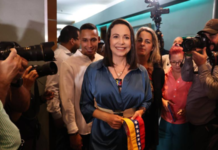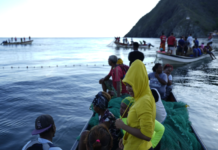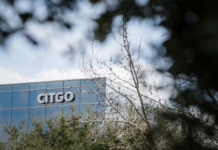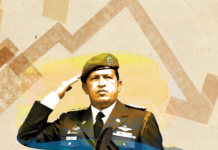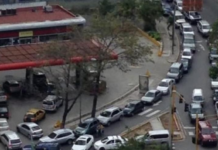[ad_1]
I needed to get to Bogotá from my home not too far from Barquisimeto. The thing is, there’s no good way to get there from here: certainly no direct flights.
After weighing my options, I decided to fly from Cúcuta. It’s 70% cheaper than flying from Caracas, and Barquisimeto is almost closer to the border than to Maiquetía airport.
Of course, that meant getting to Cúcuta by land: a 7 or 8 hour ride. I set off not knowing exactly what to expect from the disgusting, ramshackle mess that is the Barquisimeto Bus Station.
Who pays Bs.13.000 for a ride and brings with him 100 dollars to go shopping in Cúcuta?
Soon after the Colombian border was reopened, I read about some “tours” to Cúcuta to shop for hard to find goods, but at the time I thought it was an eccentricity of the few better off people still hanging on in Barquisimeto; something quince y último-dependent cestaticket mortals like me couldn’t dream of.
Who pays Bs.13.000 for a ride and brings with him 100 dollars to go shopping in Cúcuta?
More people than I thought, it turns out.
As I got on the rickety old Encava, one thing became clear right away: people talk on these buses. As we stopped for gas, my seat neighbor, Richard, got to talking. He’s a guaro in his late twenties,
– ”Are you from San Cristóbal?”
– “No”, I answer. “I’m from here but I’m heading to Colombia”.
Immediately he began telling me that he was also going to Cúcuta, first time, to do some shopping. Food mostly. That segued seamlessly into a rant about the economy, Maduro, lo jodida que está la vaina, the usual.
A few hours later, on another stop, another passenger approached me. Mr. Humberto is from San Felipe, in Yaracuy State (my own birthplace) and is also going to Cúcuta. He asks whether I cross the border frequently. He wants to know how hard it might be to pass groceries to this side.
I told him I hadn’t crossed the border since last year, before it was shut, and at that time it wasn’t hard at all to bring your shopping into Venezuela. You only had to carry the invoices of everything.
Richard then joined us and reminded Humberto that there is a limit of six items of each product that can be bought and passed without getting in trouble with the National Guard.
I was impressed by the preparation of my travel companions aboard our unfit-for-longer-than-two-hours-trips ENCAVA.
Humberto didn’t seem worried by this arbitrary cap.
“I have a compadre in San Cristóbal where I can store my bags, so I can go back and forth several times with six items each time”, he said.
I was impressed by the preparation of my travel companions aboard our unfit-for-longer-than-two-hours-trips ENCAVA. They were all about logistics.
As the sun started to rise and we were getting closer to San Cristóbal, the bus driver turned to us “Who is going to San Antonio?” A staggering 80% of the passengers raised their hands. He offered to drive us to San Antonio for an extra Bs 800. Everybody agreed.
That saved us at least three hours stopping over at San Cristobal Terminal. While we drove the winding road that connects San Cristóbal and San Antonio, some people changed seats to avoid the sun.
I meet a whole family travelling together: the patriarch, Luis, his wife Magaly, his kids Luis Andrés, Emilia and María Luisa his son-in-law Jorge and little Javier (still in Emilia’s arms). They’re a Christian family from Marín, in Yaracuy state, and they’re not going to Cúcuta to shop, they’re going to stay.
Mr. Luis praises the landscape of the Tachirense Andes and the cold. He tells us Mrs. Magaly has been working in a shoe factory for a month and traveled to Yaracuy to pick up her family. Mr. Luis explains that he’s a metalworker, with experience working for a cooperative that contracts with PDVSA; and adds, full of hope, that he heard that someone with his skills may earn over two million pesos in Colombia — that’s $630, an unheard of windfall in Venezuela. We make it to San Antonio, get off the bus and wish each other luck.
In San Antonio
San Antonio’s main street leads to the Customs House and the Simón Bolívar bridge, the gateway to Colombia. It looks busy, with people carrying suitcases and backpacks, handbags and plastic bags up and down. It feels almost like a tourist town, full of people with different accents and backgrounds.
Mr. Camilo crossed to the Venezuelan side to buy an engine belt for his car.
As I get closer to Customs and Border control, the street narrows and the crowd thickens. By this point the road is closed to traffic, there’s just a throng of pedestrians all over the pavement.
Mr. Camilo walks next to me towards Colombia, he’s born and raised in Cúcuta and crossed to the Venezuelan side to buy an engine belt for his car.
“It cost me less than half here,” he says, laughing, and the comments on the flow of people coming from the Colombian side carrying large packages of food, tires and almost any kind of goods.
“That’s it, thank Maduro for all of this, because he’s to blame for the situation,” he said without realizing his own irony: he should also thank Maduro for allowing him to buy the belt for his car with a 60% subsidy without having ever paid a single Bolívar in tax for it.
Negotiating the Border
Bizarrely, Colombia is the South American country where it is hardest for Venezuelans to legally immigrate. The different kinds of visas issued by the Colombian Foreign Affairs Ministry are each more complex than the next.
Sadly, Mr. Luis’s chances of getting a job that pays the two million pesos he’s dreamed of are not great: the TP-4 visa (for work) is hard to get. There are reports that up to 90% of requests are denied, particularly those that don’t involve highly specialized work or top management positions in big companies.
Given the large number of Venezuelans that enter as tourists and then stay to work illegally, immigration authorities have gotten tougher.
Until 2014, Venezuelans had the option of applying for a TP-15 visa (Mercosur), with minimum requirements, granted under the free movement treaties signed by the member countries of Mercosur, and associates like Colombia. But, as we learned recently, Venezuela hasn’t ratified the agreements, and the Republic of Colombia, acting on the principle of reciprocity, stopped issuing TP-15s to Venezuelans.
Even entering as a visitor has gotten more difficult recently. Venezuelans are issued an Entry Permit that’s good for up to 90 days. But given the large number of Venezuelans that enter as tourists and then stay to work illegally, immigration authorities have gotten tougher.
The office of Migración Colombia is at the end of the Simón Bolívar bridge, after a checkpoint through which only one person can pass at once.
A bit farther, the flow of people splits up between those on their way to Cúcuta (who don’t need their passports stamped) and those hoping to get to the rest of Colombia. The line for stamping passports is several dozen people long, something I’d never seen in Cúcuta. Outside, there are people lying on the floor, leaned back over their luggage, while some others bargain with taxi drivers.
Jorge is a lad from Mérida state, hoping to transit through Colombia on his way to Ecuador. Immigration demanded a ticket from Cúcuta to Ipiales, on the Ecuadorean border, to let him through. He’s in line behind me and tells me that at his first attempt he didn’t get his passport stamped, and he had to hire a taxi to the Cúcuta Terminal, buy the bus ticket and return to the border post, ticket in hand.
Stories about rejected peeps that weren’t let in abound in social media. Until last year you only had to give the officer an address and a phone number in Colombia, but now the protocol requires to either prove means of support or hand in a letter of invitation from a Colombian citizen with photocopy of their ID, and bus or plane ticket to the destination city.
Who would have thought two years ago that we had to hold our breath in front of a Migración Colombia officer?
When my turn comes, the officer takes my passport and asks me where I’m going, for how long, what I’m going to do there and who invited me; he then meticulously verifies the documents and asks me to repeat my answers.
I felt like I was entering Iran or North Korea.
Who would have thought two years ago that we had to hold our breath in front of a Migración Colombia officer?
#ElLegado.
I get my passport stamped and head out, Jorge is there too, happy because he’ll be allowed to continue his journey.
Jorge is heading for Quito looking for a better life. His cousins are expecting him, they’ve been there for months.
In Cúcuta
Although I barely know Cúcuta as a stop-over, they say it’s always been buffeted by border upheavals and was heavily impacted by the closure in 2015. Nevertheless, these days Cúcuta looks particularly flourishing, with buoyant commerce thanks to the massive incoming flow of Venezuelans, not only from the surrounding areas, but from all over the country.
I took a bus to the Bus Terminal in downtown Cúcuta, where I wanted to stop to exchange money. The bus fills up with Venezuelans that just crossed the bridge and head to the city center to go shopping. As I get in, Andry, who comes from Valencia, asks the bus driver “How much is it in Bolívares, sir?”; “800 bolos” he gets for an answer.
In Cúcuta, public transportation and many stores accept Bolívares, calculated at the exchange rate of the day. Last time I had taken a bus there, over a year ago, I paid Bs. 200 for the same 1,600 pesos (50 US cents) that the bus ride still cost. From the very first transaction we make as newly arrived Venezuelans we feel the exchange disadvantage. To put it in perspective, the bus ticket from Barquisimeto to San Cristóbal, an 9-hour road trip, cost me Bs 3,500; only a bit more than two round trips through the city of Cúcuta. And I’m talking about late September; this situation has gotten considerably worse for Venezuelans in the last few weeks.
I ask the young man from Valencia how many people came with him. His answer stuns me: 63, two buses that departed the previous afternoon. He came looking mostly for toiletries. He needs enough for his entire family.
At Cúcuta’s Bus Station, close to the forex bureau I was in, a young lady asks a streethawker “señora, can you tell me where they sell the invitation letters?”
The seller points to a Cybercafé.
Just like Jorge, this girl was denied entry into the rest of Colombia because she didn’t have a ticket to Bogotá or an invitation letter, so she was given the chance to look for the requirements during the day.
The ticket for Bogotá was easy, for 60,000 pesos (about $19) there are very comfy buses that depart throughout the day.
The invitation letter would have been an insurmountable obstacle, because she didn’t know any Colombians. Never fear, the cybercafé will sell a letter to anyone for 20,000 pesos — $6.30.
The merry fraudster told me he sells about 30 letters every day, all signed by the same person.
“You gotta memorize the name and the address”, the guy at the cybercafé tells her. “If they ask you who’s inviting you and you don’t say the same name, pailas!”
I thought to myself that it has to be a hell of a house the Colombian who signs all these letters must have in Bogotá. The merry fraudster told me he sells about 30 letters every day, all signed by the same person.
Camilo Daza
Going to Cúcuta’s Camilo Daza Airport I realized that everything I’ve seen in Cúcuta relates one way or the other to Venezuela and its people. This is confirmed when I get to the airport.
Camilo Daza doesn’t look remotely close to the airports that serve places like Barquisimeto, Las Piedras or El Vigía (to name a few I know), and yet there was this feel of familiarity around. Though small, the privately managed airport feels new and busy, with spacious lounges and working toilets (yes, I know that’s the minimum we should expect from airports everywhere, but I come from Venezuela — public toilets with toilet paper amaze me).
You can tell Camilo Daza was planned for the decades to come, just the opposite of many Venezuelan airports that seem stuck in the 70s or in perpetually unfinished renovation work.
The iconic caprilera cap was visible among the passengers queueing at Avianca and LATAM counters; small shops were selling Samba, Toronto and many other Venezuelan candies; and at the food court I heard some “Na’guará“, “Qué fino marico“, and even a “Burda de calor que hace en esa vaina“.
Elisa works at a franchise that sells food in the Airport, and as she serves me a slice of pizza and a cup of coffee, with that Colombian kindness I never get used to, she tells me that the airport came back to life when the border was reopened.
Back when it was shut, she and her workmates feared for their jobs. Within the first month after the border closure, international passenger traffic fell 45% in this airport, and on last August the low fare airline VivaColombia had to terminate its route Bogotá-Cúcuta because the planes were flying empty.
That’s all a memory now: occupancy has shot up in all the routes now, particularly to Bogotá. My flight, for one, is full.
I had a long wait ahead, but like a good Venezuelan, I had no trouble finding conversation partners.
There were people from all over Venezuela and every different background, but the leitmotiv was the same: running away from the crisis, open to new horizons, looking opportunities.
Antonio is an Engineer who’s been working for several years for a multinational. “At Procter & Gamble I was very well paid, I changed my car every year, went on vacations with my family and had some savings. Now none of that is possible.”
Antonio was heading to Lima, Perú, alone, taking a job opportunity that came up on short notice.
“I didn’t quit my job in Venezuela, I’m currently on a medical leave and then I’ll be on my legal vacation, that will give me two months to find out if I can settle down in Perú.”
I ask him why he’s traveling via Cúcuta and not from Maiquetía, which was closer to him.
“It was too expensive, chamo. $600 a ticket”. If he succeeds in Perú, he adds, he’ll quit his job in Maracay and take his family with him.
Some 23 hours after leaving home, I finally board my flight to Bogotá’s El Dorado airport. Tired as expected, I still have energy for one last chat with my seat neighbor.
Linda is from Caracas, a preschool teacher who worked for four years for the Government. She’s on her way to Bogotá because a friend invited her “to try my luck”, as she put it.
“Even sweeping floors you’re better off in Colombia than in Venezuela.”
She explains that she’s not bringing her documents or her Diploma, “there were no appointments for validation and legalization, and gestores (private paperwork agents) charge too much.”
But she’s optimistic: “Even sweeping floors you’re better off in Colombia than in Venezuela.”
Linda is very well aware of the limitations that come with working in Colombia without a visa and without certified qualifications, but desperation drove her out of her comfort zone — it wasn’t actually comfortable anymore.
“I hope to stay here in Colombia for as long as I’m allowed, make some money and then move to another country where I can practice my profession.”
Finally I arrive to Bogota’s “El Dorado”, which like that mythical Dorado from the days of the Spanish conquest, is a promised land of sorts to Linda, just like Cúcuta is to Don Luis and his family, like Quito is to Jorge, and Lima to Antonio.
All part of the Venezuelan diaspora of the XXI century that shows no signs of abating anytime soon and that knows Maiquetía is not the only way out.
Related
[ad_2]
fuente
